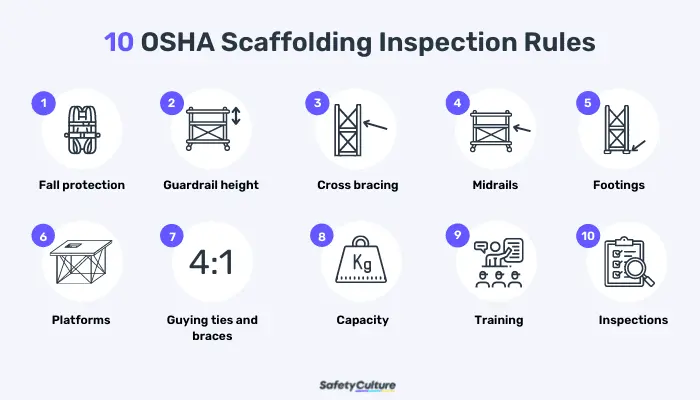OSHA Scaffolding Inspection Rules
Most injuries can be prevented by following scaffolding safety precautions dictated by OSHA scaffolding regulations, but bad habits do occur.
OSHA has compiled all the scaffolding rules and standards to ensure that businesses, especially those in the construction line of work, establish safety protocols and protect their workers from harm. OSHA issued several key provisions that employers need to take note of when using scaffolds.
Here are the highlighted rules of OSHA’s scaffolding standard:

1. Fall protection
Employees that are more than 10 feet off the ground need to be protected by using fall arrest systems or guardrails, except for employees that are on single-point and two-point adjustable suspension scaffolds. These employees should be protected by using both guardrails and a personal fall arrest system.
2. Guardrail height
Guardrails are visible and physical barriers used for preventing falls from heights. The height of the scaffolds’ toprail that was manufactured and used in service after January 1, 2000 should fall between 38 inches and 45 meters. Before this date, the scaffolding standard was 36 inches to 45 inches.
3. Cross bracing
Cross bracing is a technique in the construction industry whereas braces are crossed to support framed structures such as scaffoldings. Using this technique makes frames and structures sturdy and is able to support and hold heavy loads. As a standard, crosspoint of cross bracing used as a top rail should be between 38 inches and 48 inches above the work platform.
4. Midrails
Midrails are the middle bars in the rails of a scaffolding. It ensures that a worker does not fall through. This has to be installed approximately midway between the toprail and the platform surface. The crosspoint of cross bracing used as midrail should be between 20 inches and 30 inches above the work platform.
You can also find online checklists that you can use as guide in ensuring safe installation of midrails.
5. Footings
Scaffold footings have to be leveled and have the capacity to support the loaded scaffold. The legs, poles, frames, and other upright components should carry the weight off the base plates and mud sills.
6. Platforms
OSHA requires that scaffold platforms should be fully planked or decked and have proper guardrails, midrails, and toe boards along its open sides. It should be regularly cleaned and properly cleated to prevent accidents caused by slipping off.
7. Guying ties and braces
Guys, ties, and braces are used to provide additional support for workers when using scaffoldings to prevent tipping. It should be installed according to the scaffold manufacturer’s recommendation or when the base reaches a height ratio of 4:1.
8. Capacity
This refers to the loading capacity of a scaffolding equipment. It is required that every scaffold and its components should be able to withstand support 4 times the maximum intended load without failure.
9. Training
OSHA requires employers to provide training for each employee involved in scaffolding work. The training should include:
- proper handling and use of the scaffold and the materials on it;
- hazards associated (e.g., electrical, fall, and falling objects) to the type of scaffold being used;
- methods of controlling and minimizing those hazards;
- maximum intended load and load-carrying capacities of scaffolds being used;
- And other relevant requirements for scaffoldings.
10. Inspections
It is required that a visual inspection be conducted by a competent person before the start of every shift and after conducting work. Identifying defects through regular inspections can help minimize and eliminate hazards that can affect the structural integrity of the scaffolding and threaten the safety of the worker and the workplace.
Improve your GRC management
Simplify risk management and compliance with our centralized platform, designed to integrate and automate processes for optimal governance.
Explore now

